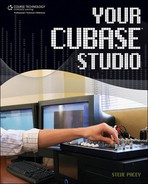Using VST Instruments
As I mentioned before, Cubase comes with a set of VST instruments that depend on the version. At this time there are three main types of VST instruments: virtual synths, virtual sample players, and virtual musicians. Cubase 4 comes with a few different virtual synths and one virtual sample player called HALion One. One of the great things about VST instruments is that you can use multiple instances of each instrument. This means that you can use your single HALion One VST instrument to play, for example, 16 different samples at once, or as many as your system can handle.
Virtual samplers work by playing a digital recording stored on your computer. In some complex sample programs, each note on a keyboard can actually trigger several samples at once, creating a layered sound that changes depending on how hard a key is pressed. These virtual sample players use your hard drive more than they do your RAM or CPU by quickly accessing stored audio files from the hard drive upon demand. Most virtual sample players also include a synth filter (or multiple filters), which can be used to process the sample in a variety of ways. For example, this synth filter could be used to change the attack or decay of the sample, or it could send the sampled sound through a virtual oscillator to change its tonality. These synth parameters can be controlled with automation using Cubase to create some complex sound textures. The more synth parameters used in a virtual sample player, the greater the load on the CPU (because the synth portion of a virtual sampler requires processing power).
Virtual synths come in many varieties. Some start with a sampled wave and allow you to manipulate and combine samples to create unique textures. Other virtual synths start with a simple waveform type and allow you to manipulate it in a variety of ways. Programming synths can become quite an art in itself and requires a lot of understanding of each synth component. Most synths come with a variety of presets (or patches) that allow you to play around without getting in over your head with programming.
Virtual musicians are usually a combination of samplers, REX file players, and MIDI files and actually play prearranged parts on an instrument in time with your MIDI sequence. These VST instruments allow you to program chord/time changes to the MIDI track without spending a lot of time recording individual parts. Even though this type of VST instrument can be limiting, it’s amazing what you can do with these when you apply a little extra MIDI and digital recording knowledge to the mix. Steinberg offers several virtual musician-type plug-ins, such as Virtual Guitarist, Groove Agent, and Virtual Bassist.
